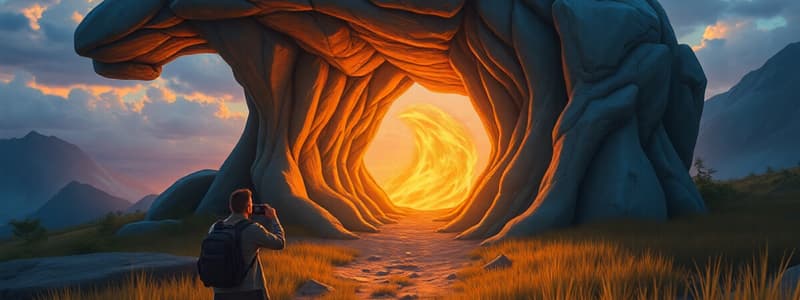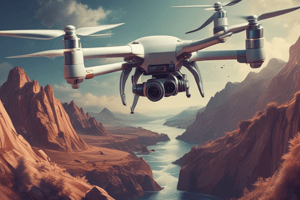Podcast
Questions and Answers
Ce tipuri de camere sunt menționate în videografie?
Ce tipuri de camere sunt menționate în videografie?
- DSLR, camere mirrorless, camere de cinema (correct)
- Camere de tip smartphone, camere de acțiune
- Camere analogice, camere digitale simple
- Camere de supraveghere, camere video de mână
Care dintre următoarele tehnici de iluminare este fundamentală pentru a sculpta scena?
Care dintre următoarele tehnici de iluminare este fundamentală pentru a sculpta scena?
- Iluminarea dramatică
- Iluminarea de fundal
- Iluminarea cheie (correct)
- Iluminarea de umplere
Care setare a camerei controlează profunzimea de câmp?
Care setare a camerei controlează profunzimea de câmp?
- ISO
- Shutter speed
- Apertura (correct)
- Cadrarea
Ce tip de microfon ar fi cel mai potrivit pentru interviuri?
Ce tip de microfon ar fi cel mai potrivit pentru interviuri?
Care software de editare este folosit pentru editare non-liniară?
Care software de editare este folosit pentru editare non-liniară?
Care dintre următoarele principii de sunet este esențial pentru creația audio?
Care dintre următoarele principii de sunet este esențial pentru creația audio?
Ce principiu este important în utilizarea iluminării pentru a crea o atmosferă specifică?
Ce principiu este important în utilizarea iluminării pentru a crea o atmosferă specifică?
Care techinca de editare permite aranjarea footage-ului și sunetului în mod flexibil?
Care techinca de editare permite aranjarea footage-ului și sunetului în mod flexibil?
Care este impactul utilizării tehnicii 'rule of thirds' în compunerea unei scene?
Care este impactul utilizării tehnicii 'rule of thirds' în compunerea unei scene?
Ce efect are iluminarea de fundal asupra unei scene?
Ce efect are iluminarea de fundal asupra unei scene?
Flashcards
Videografie
Videografie
Procesul de captare a imaginilor în mișcare, de la planificare și filmare până la post-producție.
Tehnicile de iluminare
Tehnicile de iluminare
Tehnici de iluminat - iluminare principală, iluminare de umplere și iluminare de fundal - pentru a modela scena și a crea adâncime.
Formatul camerei
Formatul camerei
Specificații tehnice ale unei camere video, incluzând rezoluția (HD, 4K) și cadre pe secundă (FPS).
Înregistrare audio
Înregistrare audio
Signup and view all the flashcards
Software de editare
Software de editare
Signup and view all the flashcards
Tehnicile de cadrare
Tehnicile de cadrare
Signup and view all the flashcards
Iluminare adecvată
Iluminare adecvată
Signup and view all the flashcards
Setări cameră
Setări cameră
Signup and view all the flashcards
Mișcări cameră
Mișcări cameră
Signup and view all the flashcards
Tipuri de camere
Tipuri de camere
Signup and view all the flashcards
Study Notes
Videography
- Videography encompasses the process of capturing moving images, from planning and filming to post-production.
- Key aspects include pre-production (planning), production (shooting), and post-production (editing).
- Understanding different camera formats (e.g., HD, 4K) and frame rates is crucial for quality video.
- Lighting, composition, and sound are all essential elements of effective videography.
Camera Techniques
- Different camera types (e.g., DSLR, mirrorless, cinema cameras) offer varying features and functionalities.
- Understanding camera settings like aperture, shutter speed, and ISO is essential to control exposure and depth of field.
- Framing and composition techniques (e.g., rule of thirds, leading lines, symmetry) can significantly impact the visual appeal of a video.
- Masterful use of camera movements like tracking shots, dolly shots, and zoom shots adds dynamism and visual interest, enhancing the storytelling aspect of video content.
Lighting Principles
- Lighting profoundly affects a video's visual quality and mood.
- Key lighting, fill lighting, and backlighting are fundamental lighting techniques to sculpt the scene and create depth.
- Lighting direction and intensity heavily influence the scene's atmosphere, whether it is bright daylight, dramatic night, or studio-controlled lighting.
- Understanding color temperature (e.g., warm, cool) is important to create a specific mood, with appropriate colour correction techniques available in post-production.
- Different lighting setups (e.g., three-point lighting) achieve varying moods and effects.
Audio Recording
- High-quality audio is vital for any video, enhancing viewer engagement and understanding.
- Using microphones (e.g., lavalier, shotgun) and audio recording equipment tailored for specific needs (environmental recordings, interviews) improves quality and clarity.
- Recording sound in sync with the video is crucial for maintaining accurate timing and seamless playback.
- Audio editing, noise reduction, and sound effects all aid in enhancing the final product.
- Consider sound design principles to create effective audio mixes, suitable background music, and sound effects to improve narratives and emotions.
Editing Software
- Editing software (e.g., Adobe Premiere Pro, Final Cut Pro, DaVinci Resolve) is used for non-linear editing.
- These tools allow for the manipulation and arrangement of recorded footage and audio.
- Software features include video trimming, colour correction, special effects, and transitions.
- Editing involves selecting, arranging, and assembling clips, along with effects and transitions, to tell a story and achieve the desired artistic vision for the content created.
- Knowing different editing techniques, styles, and potential software effects is vital for creative output.
- Understanding workflows within the chosen editing software is crucial to maintain efficiency.
- Knowledge of different file formats, codecs, and export settings ensures compatibility and quality.
Studying That Suits You
Use AI to generate personalized quizzes and flashcards to suit your learning preferences.




